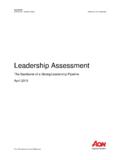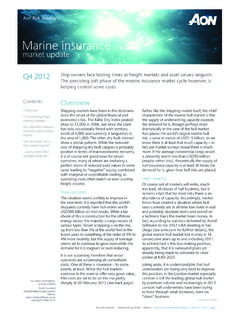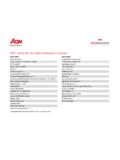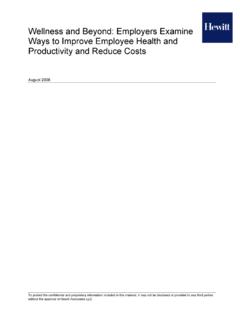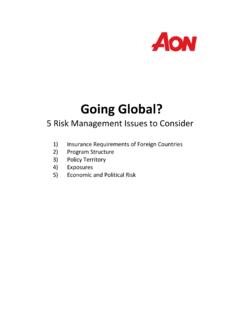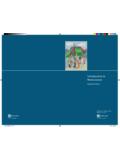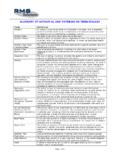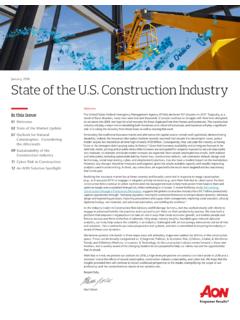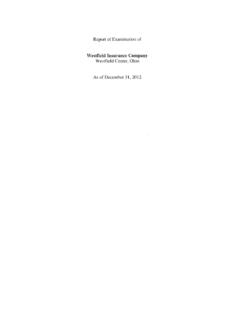Transcription of Chile: One Year On - Health | Aon
1 February 2011 chile : One year OnreDEFININGC apital | Access | Advocacy | Innovation1 Aon BenfieldTable of ContentsIntroduction 3 The Science Behind the Earthquake 4 The seismology 4 The tsunami 5 Looking forward 6 The reinsurance Market 7 Before Maul 7 Impact of a mega earthquake 7 Lessons Learned 8 Insurance companies 8 Challenges 8 Claims 9 Regulatory Framework 10 Future modifications 10 Catastrophe Modeling 10 The Future for chile and Beyond 11 Catastrophe models 11 Data quality 11 Non-modeled peril: tsunami 11 Contact Information 12 About Aon Benfield 132 chile : One year On3 Aon BenfieldIntroductionThe Maul earthquake was the event of the decade for insured natural catastrophes in Latin America.
2 Ultimate insured losses are expected to settle at billion making Maule the costliest insured earthquake since the 1994 Northridge event in California. The event served as a test of the Chilean insurance market, throwing into the spotlight its contingency plans, the regulatory framework, construction codes and ultimately the effectiveness of the reinsurance market. Overall, the system designed to protect the public and insurance companies proved effective. From a reinsurance perspective, insurance companies were able to see that their cover not only provided an accretive form of capital, but that they had purchased sufficient limits to protect their balance sheets and meet their obligations to the insureds of chile .
3 The majority of the insured losses were reinsured in the international market; roughly 95% of which were ceded via reinsurance . This report examines the science behind the event, lessons learnt for the insurance industry and future expectations. Aon Benfield s goal is to deliver relevant research to insurers and reinsurers underwriting risks in both chile and some of the world s most earthquake prone areas. We aim to create a more risk aware world so clients, governments and non-governmental groups are better able to protect and grow their organizations in the face of natural hazards and accompanying socio-economic is drawn from Aon Benfield s broking and Analytics teams, including onsite visits, coupled with scientific knowledge from the Aon Benfield UCL Hazard : One year OnThe Science Behind the Earthquake The first anniversary of the Maul earthquake in chile on 27 February 2010 provides a useful point on which to review the results of the first wave of scientific investigations.
4 These are focused mainly upon post-event surveys aimed at understanding the damage from the earthquake and tsunami, in addition to the effects on the landscape of the earthquake has now been assessed as the fifth largest to have occurred since 1950. In this period, its moment magnitude (Mw) of has been exceeded only by the 1952 Kamchatka, 1960 chile , 1964 Alaska and 2004 Sumatra earthquakes. All of these, including the Maul earthquake, were interplate subduction zone earthquakes produced by slip on the interface between a down-going oceanic plate and an overlying continental margin: in this case, between the Nazca oceanic plate beneath the eastern Pacific Ocean and the South American plate.
5 Ongoing advances in seismic monitoring and the interpretation of seismic records mean that the Maul earthquake and the Sumatra earthquake are by far the best understood of the five. The seismologyThe earthquake occurred along a 650km long section of the subduction zone, between the rupture zones of the 1906 earthquake to the north and the 1960 earthquake to the south. This section had previously ruptured, at least partially, in earthquakes in 1730, 1751, 1822 and BenfieldThe 2010 rupture began in an area between these two segments and propagated mainly to the south-south-west in the first 40 seconds of the earthquake. It then developed bilaterally with a major rupture propagating into the northern segment.
6 The whole earthquake rupture only lasted 110 seconds, with velocities in the order of to 3km per second. The 2010 earthquake was therefore a multi-segment rupture and analogies may be drawn between central chile and the multi-segmented Nankai trough subduction zone off Japan. The northern segment saw the largest fault displacements, with up to 16m of slip just off the coast southwest of Valpara so. Elsewhere slip was only about 5m, with a notable minimum in the area to the west of the initial rupture. Intense earthquake damage in certain areas, such as Constituci n (close to the northern high-slip area) and Talcahuano Concepci n (at the southern end of the rupture) may be related to features of the fault rupture process.
7 A second notable feature of the 2010 earthquake was that the slip was confined to a relatively narrow depth along the subduction zone, with about 30% of the rupture zone located landwards of the chile coast. The positions of both the down-dip (landwards) and up-dip (seawards) limits of the rupture zone were important in controlling the effects of the earthquake. The down-dip boundary is important because it controlled the landward limit of the most intense seismic shaking and therefore reduced the intensity of shaking experienced in inland cities such as Santiago. The up-dip limit of rupture was not far offshore, where the plate interface was well below the surface, and may have been important in reducing the size of the position of the fault rupture relative to the coastline also controlled the distribution of uplift and subsidence along the coast.
8 The deformation influenced the tsunami damage, which was greatest on coastlines that had just subsided in the earthquake and least in areas that had just been uplifted. The tsunamiThe 1960 earthquake produced major tsunami damage and deaths as far away as Hawaii and Japan. By contrast, the destructive effects of the tsunami from the 2010 earthquake were largely confined to the coast of chile in and near the rupture zone. In addition, the islands of Juan Fern ndez (700km offshore) and Marquesas (in French Polynesia to the west-north-west) suffered because they lay in the path of the main beam of the surveys have established that maximum tsunami run-ups were around 10m on the coast of chile and 5m at Juan Fern ndez.
9 Tide gauge records, coastal observations and data from offshore tsunami detection system showed that wave heights and run-ups further afield were almost all below 1m and mostly below , causing little or no direct damage. The Maul earthquake is in fact the only one of the five largest earthquakes of the last 60 years not to have caused significant direct tsunami damage at transoceanic fault did not rupture significantly seawards of the coast so the size of the tsunami was limited in comparison to those generated by other subduction zone earthquakes. These include the 1952 Kamchatka, 1960 chile , 1964 Alaska and 2004 Sumatra earthquakes. While the earthquake produced strong seismic waves and intense shaking, the actual uplift of the seabed in the chile trench was relatively small and, as a result, the earthquake was not an efficient tsunami : One year OnLooking forwardThe 2010 earthquake and its effects have important implications for similar events in the future, both in chile and around the of deformation provides insight into its potential effects upon likely future earthquake occurrences in chile .
10 The earthquake will have placed extra stress on strike-slip faults in the upper plate, along the coastal ranges of chile . Whilst such strike-slip earthquakes would be small compared to the 2010 earthquake, proximity to population centers increases the potential for local damage. It has been proposed (Lorito, 2011*) that the area near the epicenter, which experienced relatively little slip in the earthquake, may also be at significant risk from a further earthquake on the plate interface itself. However, it is unlikely that such an earthquake would be larger than Mw , as demonstrated by the recent earthquakes in this region of chile during early distributions from the earthquake also provide evidence of its effects upon adjacent fault segments.
